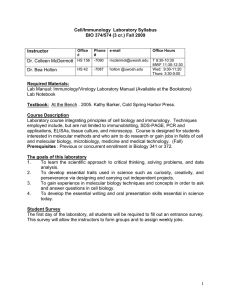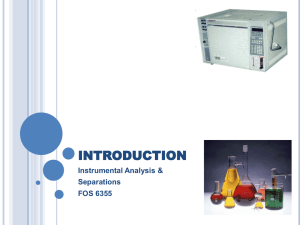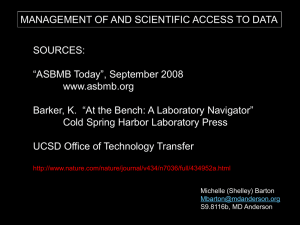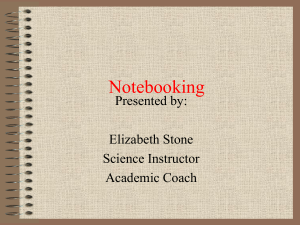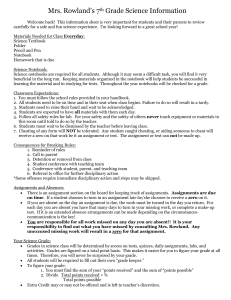Immunology/Virology Laboratory Syllabus
advertisement
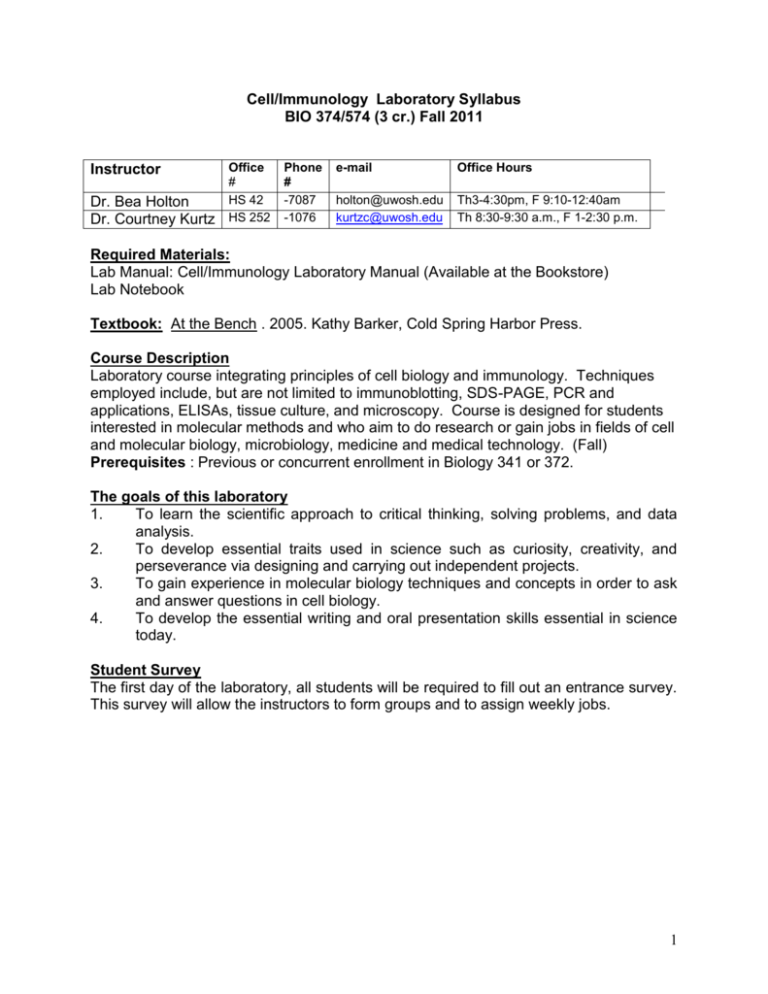
Cell/Immunology Laboratory Syllabus BIO 374/574 (3 cr.) Fall 2011 Instructor Dr. Bea Holton Dr. Courtney Kurtz Office # HS 42 HS 252 Phone # -7087 -1076 e-mail Office Hours holton@uwosh.edu kurtzc@uwosh.edu Th3-4:30pm, F 9:10-12:40am Th 8:30-9:30 a.m., F 1-2:30 p.m. Required Materials: Lab Manual: Cell/Immunology Laboratory Manual (Available at the Bookstore) Lab Notebook Textbook: At the Bench . 2005. Kathy Barker, Cold Spring Harbor Press. Course Description Laboratory course integrating principles of cell biology and immunology. Techniques employed include, but are not limited to immunoblotting, SDS-PAGE, PCR and applications, ELISAs, tissue culture, and microscopy. Course is designed for students interested in molecular methods and who aim to do research or gain jobs in fields of cell and molecular biology, microbiology, medicine and medical technology. (Fall) Prerequisites : Previous or concurrent enrollment in Biology 341 or 372. The goals of this laboratory 1. To learn the scientific approach to critical thinking, solving problems, and data analysis. 2. To develop essential traits used in science such as curiosity, creativity, and perseverance via designing and carrying out independent projects. 3. To gain experience in molecular biology techniques and concepts in order to ask and answer questions in cell biology. 4. To develop the essential writing and oral presentation skills essential in science today. Student Survey The first day of the laboratory, all students will be required to fill out an entrance survey. This survey will allow the instructors to form groups and to assign weekly jobs. 1 Week Techniques to be Learned/Experimentation 1 Laboratory Safety/ Student Surveys/Use of Micropipettes Making Buffers, Experimental Design 2 ELISA and Intro to Statistics 3 Cell Culture and Cell Counting 4 Immunostaining and Flow Cytometry 5 Immunoblotting 6 Immunoblotting (cont.) 7 Cell Function Assay 8 PCR and RT PCR 9 PCR and RT PCR (cont.) and Group Project Approval 10 Experimentation Phase 11 Experimentation Phase 12 Experimentation Phase 13 Wrap it Up! Work on written paper and oral presentation. 14 Peer Review: Oral Presentations Date Sept. 8 Sept. 15 Sept. 22 Sept. 29 Oct. 6 Oct. 13 Oct. 20 Oct. 27 Nov. 3 Nov. 10 Nov. 17 Dec. 1 Dec. 10 Dec. 15 Independent Investigations Students will design a series of experiments to focus on testing an hypothesis on interest. These are open-ended laboratories and many types of questions may be pursued with the consent of the laboratory instructors. In the schedule, this is the Experimental Phase. Laboratory notebooks EACH STUDENT is required to keep a laboratory notebook containing a record of everything covered or done during the lab session. The laboratory notebook should be detailed enough to serve as a guide for someone else doing the experiment who wants to reproduce your results. It must include the lab protocol! Either re-write or paste in the protocol from Cell/Immunology Laboratory Manual and write in any modifications or notes with the procedure. Students should record everything they do in the lab exercise (including any deviations from the protocol e.g. “I dropped my gel on the floor” or “I forgot to add ___to my reaction”). Everything observed (results) and any conclusions should also be recorded. READ CHAPTER 5 LABORATORY NOTEBOOKS in At the Bench: A laboratory Navigator by Kathy Barker. Pay particular attention to p. 92 (note the contents of a lab notebook e.g. TABLE OF CONTENTS, Dates, Title of Experiments, Purpose/Hypothesis, Methods, Results and Discussion of experimental aberrations etc.) Grading laboratory notebooks Notebooks will be collected SPONTANEOUSLY on 2 separate occasions and at the end of the semester for grading. Keep up with it! Peers will evaluate the lab 2 notebooks for 2 of 3 of the collections. Instructors will evaluate the notebooks at the end of the semester. Peers will be given 10 pts. to critically evaluate notebooks. Lab notebooks will be graded for 1) detail (reproducibility) 2) organization 3) analysis and interpretation of results. The first two collections will be peer-graded. Each peer must date and initialize their name next to the score of the notebook. It should include why points were subtracted (e.g. -4 for a missing Table of Contents etc.). At the end of the semester the instructors will evaluate the entire notebook. They will re-check peer-graded sections. If an instructor's evaluation of a peer-evaluated portion differs by more than +/-10%, the peer-grader will be penalized accordingly. Lab notebooks are critical in the experimentation environment. Today, notebooks in the private industry and academic settings are often audited. They serve as the basis for publication, invention, and patenting. Good record keeping is of major importance. Grading: A AB+ B BC+ C CD+ D DF 100-93% 92-90 89-87 86-83 82-80 79-77 76-73 72-70 69-67 66-64 63-60 <60% *Instructor reserves the right to adjust grades of the entire class if necessary (e.g. curve). Grading Point Breakdown: 5 Quizzes Written Midterm Exam Cell culture points Cell counting and statistics exercises Laboratory Notebook Grading peer notebooks Oral Presentation (1/group) Powerpoint handout Final Written “Problem Solving” Exam Group Work Evaluation TOTAL 50 pts.- See schedule below 100 pts.-Held in Polk Testing Center 30 pts. 30 pts. 60 pts. 20 pts. 100 pts. 40 pts. 100 pts. –Held in Polk Testing Center 50 pts. 580 pts. 3 Students must attend laboratory sessions. This is a lab skills course. unexcused absence will lower your grade by one full letter grade. Each Time outside of the scheduled laboratory. Students are expected to work outside of the lab. The lab will be open at appropriate times so you can complete all exercises or projects. Quiz* Quiz 1 Quiz 2 Quiz 3 Quiz 4 Quiz 5 Date Sept. 22, 2011 Sept. 29, 2011 Oct. 13, 2011 Nov. 3, 2011 Nov. 10, 2011 Midterm Exam** Final Exam** Oct. 20 or 21, 2011 Dec. 8 or 9, 2011 * Quizzes will be posted on-line on date indicated. instructors’ office on the following Monday. ** Given at Testing Center Quizzes will be turned into List of Resources available. There are numerous resources available on reserve for this laboratory course. These resources are available in 2-hour intervals. The required readings are assigned from these resources. In addition, use these resources to gather ideas and design your final project in the course. Instructions to Authors ASM format When referencing please follow this format. The instructions to this formatting will be given to you in class. It would be helpful for you to familiarize yourself with this format by paging through research articles in the ASM journals. Examples of ASM journals are: Journal of Bacteriology, Journal of Applied and Environmental Microbiology, Journal of Parasitology, Journal of Immunology, and Journal of Virology. 4 Resources Available in the Halsey Instructional Technology Center (HS 259) Current Protocols in Molecular Biology: 4 Volume Set Current Protocols in Immunology: 3 Volume Set Current Protocols in Protein Science: 2 Volume Set Current Protocols in Cell Biology: 1 Volume Genome Analysis: A Laboratory Manual Series Volume 1: Analyzing DNA Volume 2: Detecting Genes Volume 3: Cloning Systems Volume 4: Mapping Genomes Molecular Cloning: A Laboratory Manual, By J. Sambrook, E.F. Fritsch T. Maniatis,: 3 book set Antibodies, A Laboratory Manual by Ed Harlow. Culture of Animal Cells by R. Freshney Gibco BRL products & reference guide Equipment Manuals for the Horizon 58, BioRad Mini-Protean II. and BioRad Transblot Apparatus ASM Manual of Clinical Laboratory Immunology PCR Access: Promega Biotech 1996 PCR Protocols and Reference Guide Virology, A Laboratory Manual by Burleson et al. Ward, G.A., C. K. Stover, B. Moss, and T. R. Ruerst. 1995. Stringent chemical and thermal regulation of recombinant gene expression by vaccinia virus vectors in mammalian cells. Proc. Natl. Acad. Sci. USA, 96:6773-6777. Selected Chapters: At the Bench, A laboratory Manual by Kathy Barker Video: Centrifugation Hazards Video: Practicing Safe Science Additions to Syllabus for Graduate Students (Bio 547) In order to maintain the necessary rigor of the graduate experience, all dual-listed courses in our department will differ from those taken by an undergraduate. Specifically, the objectives of the course, the activities undertaken during the course and the grading scale will differ between the graduate and undergraduate versions of the course. 1. Objectives for Graduate Students a. The graduate students will be expected to evince a greater depth of knowledge than the undergraduates. This will be demonstrated on quizzes, exams, in the lab notebook, and in the independent group project. b. The graduate students will be expected to evince a higher level of synthesis than the undergraduates. This will be demonstrated in the exams and the extra oral presentation (see below). c. The graduate students will be expected to evince a more sophisticated level of communication, both oral and written, than the undergraduates. This will be demonstrated through the essay exam format used for most of this course, as well as in class discussions (both small group and whole class), extra grad oral 5 presentation, and the independent group presentation. d. The graduate students will be expected to assume a leadership role in the class, providing good models of scholarship for the undergraduates. This will be demonstrated throughout the lab activities of the course. 2. Activities for Graduate Students Activities not assigned to undergraduates. Graduate students will be the sole presenters (instead of faculty) of one of the techniques being studied in the laboratory. It will be their responsibility to give the theory and mechanics of the technique and explain these to the rest of the class in such a way that the technique will be clear. In addition, faculty will challenge the undergraduates to find flaws in the graduate students’ presentations. 3. Grading scale for those enrolled for graduate credit is more demanding than that designed for those enrolled for undergraduate credit. A = 100-94 A- = 93-90 B+ = 89-88 B = 87-84 B- = 83-80 C+ = 79-78 C = 77-74 F = < 74 . 6
